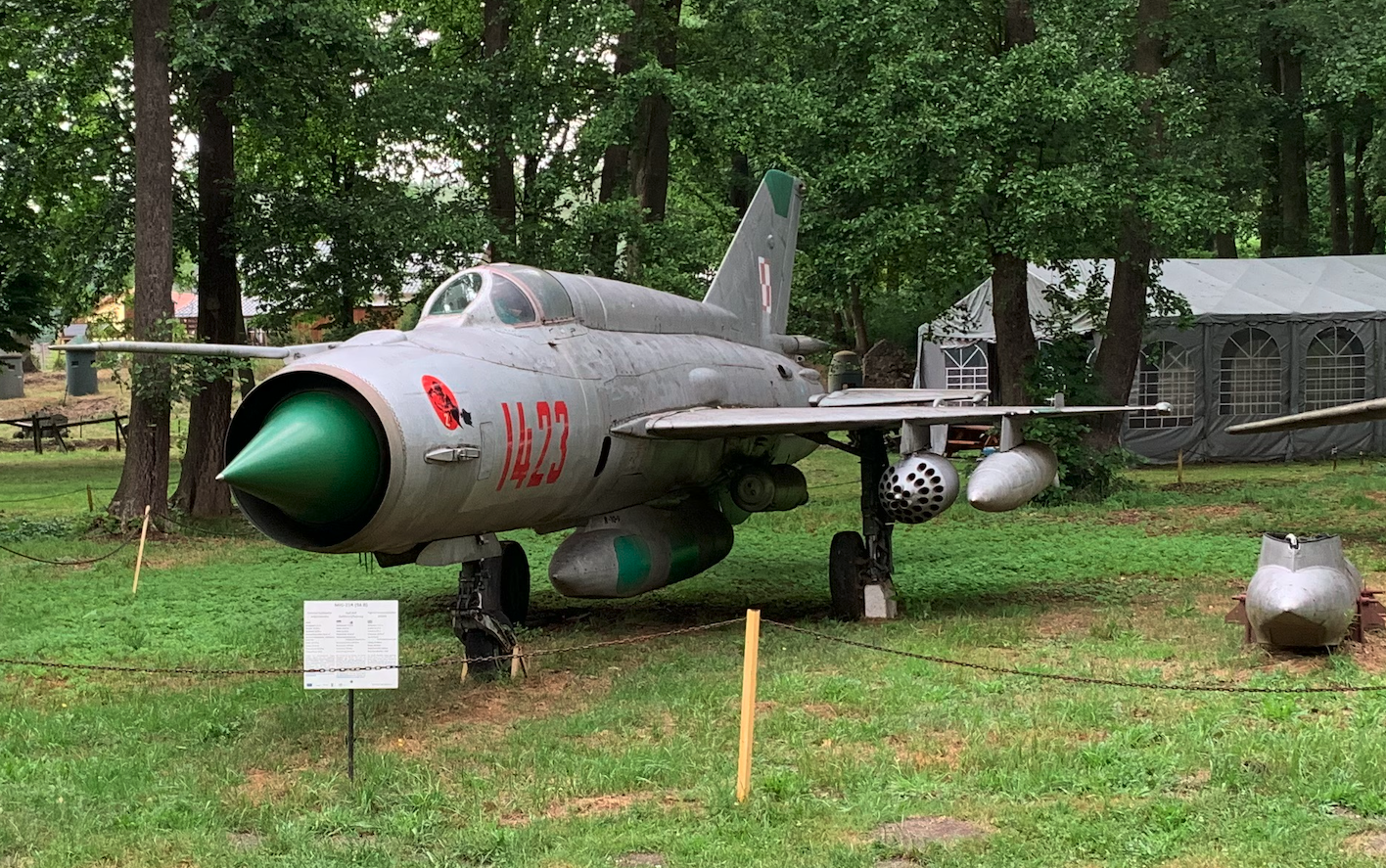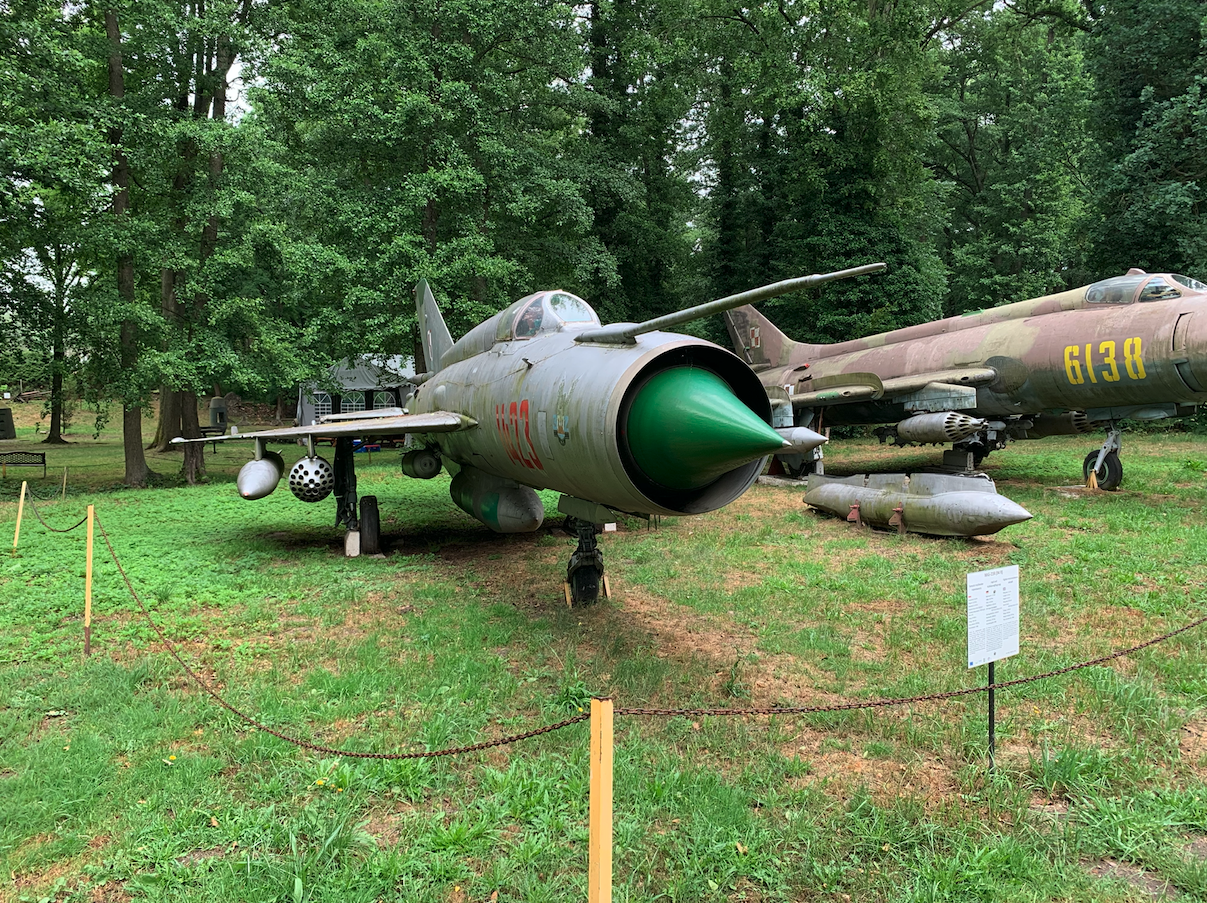Drzonów 2022-08-12
Reconnaissance aircraft MiG-21 R nb 1423.



The history of the MiG-21 R.
At OKB Mikojan and Guriewicz, the MiG-21 R (Type 94 R) reconnaissance aircraft was developed on the basis of the MiG-21 PFM fighter, with the R-11 F2S-300 engine, with the SPS (air blast on the flaps) installation. Tank No. 1 in the fuselage was removed, the tank above fuselage No. 7 was enlarged to 340 liters. The total capacity of the fuel system reached 2,800 liters. To obtain the appropriate range, the plane received two additional external suspension hooks for fuel tanks with a capacity of 2 x 490 liters. Interestingly, the plane for ferrying could carry as many as 3 suspended tanks. The ground speed was limited to 1,150 km / h.
The MiG-21 R aircraft received new equipment; AP-155 autopilot, SPO-3 warning station, which warns from all directions (SPO-2 only at the rear). This station fires automatically or manually dipoles from the ASO-21 ejector. It was also possible to manually fire PRP-26 thermal cartridges (more commonly known as flares) from the plane.
The MiG-21 R aircraft could carry the trays:
Type R - Radio-electronic reconnaissance station; SRS-6, SRS-7 M, Romb-4 A, Romb-4 B and the A-39 camera.
Type D - Daytime shooting tray for 7 cameras.
Type N - Night shooting cartridge 1 UA-47 camera and 152 FP-100 illumination cartridges.
Type SM - "SM" container was intended for the individual or mutual protection of aircraft against guided missile strikes and anti-aircraft fire by generating active and passive radio-electronic interference. For this purpose, the container is equipped with the SPS-141Je jamming station (product 141Je) and the ASO-2I-Je7R device.
Type T - Television reconnaissance cartridge, used only in CCCP, Barij-M apparatus.
MiG-21 R planes were built in Gorki in 1965-1971.
MiG-21 R in Poland. 1968.
The fact that Poland has an effective reconnaissance aviation has never been underestimated. It can be said that aerial reconnaissance was a priority in Poland. Another thing is that the CCCP did not want to equip us with the appropriate means of reconnaissance. The history of the Yak-27 R planes can be recalled.
Reconnaissance aviation at the airport in Sochaczew.
At the beginning of the 1960s, Poland had one reconnaissance regiment. It was the 21st Reconnaissance Aviation Regiment. It was based at the Bielice airport near Sochaczew. During this time, reconnaissance aviation was developing and new aviation technology was introduced. Therefore, organizational changes turned out to be necessary. On April 12, 1963, the Order of the Air Force Commander No. 030 / Org. On its basis, the 21st Reconnaissance Aviation Regiment became the 21st Tactical Reconnaissance Aviation Regiment, and on the basis of its parts the 32nd Artillery Reconnaissance Aviation Regiment was established as JW. 1031. From the beginning, the 32nd Regiment was subordinated to the Operational Aviation.
These changes became clear if we look at the equipment used by both regiments. 21. The PLRT was in stock Il-28 R, that is, long-range reconnaissance planes. On the other hand, the 32nd PLRA adopted various types of Lim planes, as well as helicopters, ie close reconnaissance, for equipment.
In 1968, the 21st PLRT was transferred to the airport in Powidz. At that time, the basic reconnaissance aircraft were: the single-seater Lim-2 R, Lim-2, the two-seater SB Lim-2 A, and SB Lim-1. The second group were helicopters; SM-1, SM-2.
MiG-21 R.
When the MiG-21 R version appeared in the CCCP export offer, the Polish Army decided to use the offer, although the analyzes showed that our needs were not fully covered.
In 1968, the first two MiG-21 R No. 94 R 011422, 94 R 01423 aircraft appeared in Poland, which replaced the Lim-2 R planes. They were put into the equipment of the 41st PLM in Malbork and began service on September 28, 1968. . In 1969, two more MiG-21 R planes arrived in Poland. In 1971, there were already 12 such planes.
It was planned that the most important fighter regiments would be equipped with a key of such aircraft. Similarly to the Lim-2 R planes. However, it turned out that the machines collect information very quickly, but then there was a problem with their interpretation in relation to the entire territory of Poland. As the range of the MiG-21 R was sufficient compared to the territory of the country, it was advisable to gather all MiG-21 R reconnaissance units in one Regiment. The choice fell on the airport in Sochaczew and the 32nd PLRA.
The next MiG-21 R reconnaissance planes bought by Poland were transported to Sochaczew on January 13, 1972 by Soviet pilots. The adopted machines had serial numbers: 94R01064, 94R021071, 94R021125, 94R021273, 94R021311, 94R021375, 94R021412, 94R022051, 94R022097, 94R022213, 94R022355, 94R022426, 94R022503 and 94R022617.
The planes, as in previous deliveries of both the R version and earlier versions, did not have tactical numbers, nationality marks, and operating inscriptions. They have already been painted in Poland.
At the same time, the Type "D" and "R" reconnaissance containers were delivered, some of which arrived installed directly on the airplanes.
In the same month (January 1972), another batch of MiG-21 R aircraft was delivered, with serial numbers: 94R021085, 94R021101, 94R021139, 94R021507, 94R022089, 94R022111, 94R022301, 94R022402, 94R022533 and 94R022657, simultaneously completing deliveries of this version.
In total, within 4 years, 36 aircraft in 5 deliveries were brought to the country, with which 32 PLRTiA were equipped, creating the core of reconnaissance aviation. The first 12 copies were also transported to Sochaczew. MiG-21 R planes served in Poland for a very long time. In 1990, there were 32 copies in the state of Polish Aviation. Due to the lack of funds, in the first half of 1991, the first batch of 7 machines was sent to the Mierzęcice airport for scrapping.
By mid-1991, the 32nd PLRT had 24 MiG-21 R aircraft and 6 MiG-21 UM aircraft. Machines intended for scrapping were newer machines, which, however, awaited a second renovation. The remaining machines had already undergone a second renovation, which was carried out at the end of the 1980s, and they still had a lot of service life ahead of them. In 1990, there were 32 of them, and in 2000, 10 more.
In 1997, 32 PLRT in Sochaczew was dissolved. His still operational MiG-21 R and MiG-21 UM planes went in full to 3 PLM (former 62 PLM) in Krzesiny. The regiment then handed over 11 operational MiG-21 Rs. Redundant reconnaissance equipment was dismantled in Krzesiny, and the planes were operated as typical fighters.
In 3 PLM / 3 ELM in Krzesiny, the MiG-21 R planes crumbled very quickly. After a year, some of them were out of order, and they had 26 years of service behind them. The last MiG-21 R was written in October 2000.
Seven machines were lost during the service, only one in the crash.
MiG-21 R nb 1423.
The MiG-21 R nb 1423 / 94R011423 was built on September 28, 1968. The plane was delivered, together with the MiG-21 R nb 1422, in 1969 to the 41st PLM in Malbork. The MiG-21 R nb 1423 aircraft was transferred to the 32nd PLRT in Sochaczew, to the 2nd Squadron. The aircraft was damaged during the service. The plane was handed over to the museum in Drzonów near Zielona Góra and is on display there until now (2022).
The MiG-21 R nb 1423 aircraft bears the emblem of the 32nd PLRT on the starboard side, and the emblem of the 2nd Squadron on the left side. The plane on the central node has a Type R container. Under the wings are suspended 2 x UB32 containers with unguided missiles. On the external suspensions there are additional fuel tanks with a capacity of 2 x 490 liters. The fuselage aircraft has rocket launch engines mounted. There is a Type D container on the ground next to the plane.
Written by Karol Placha Hetman
